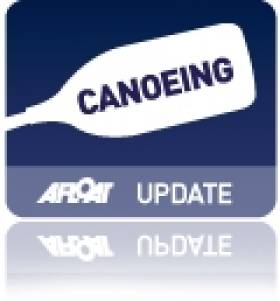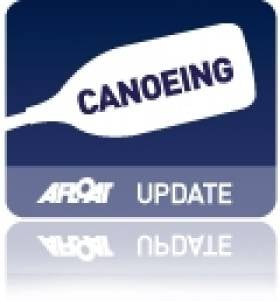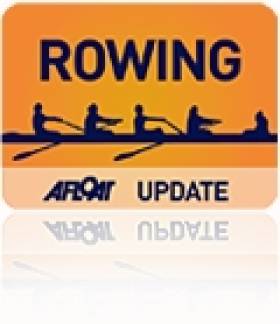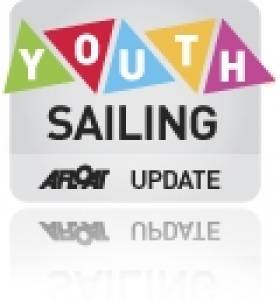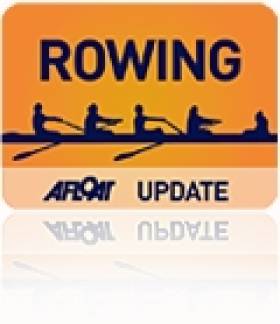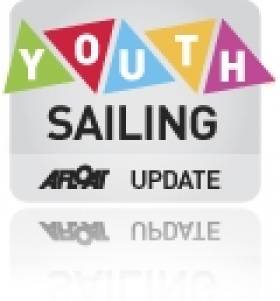Displaying items by tag: youth olympic games
Canoeist Hendrick Takes Silver for Ireland at Youth Olympic Games
#CANOEING: Ireland’s Robert Hendrick took a silver medal in the C1 Obstacle Slalom at the Youth Olympic Games in Nanjing in China. The event is run on a head-to-head format and the 16-year-old took on and beat Leon Breznik of Slovenia in the semi-finals. In the final, Hendrick lost out to France’s Lucas Roisin, who won gold. Hendrick is coached by three-time Ireland Olympian canoeist Eoin Rheinisch.
Youth Olympic Games, Nanjing, China (Irish interest)
Canoeing: C1 Obstacle Slalom – Semi-Final: 1 Ireland (R Hendrick) 1:18.752, 2 Slovenia (L Briznik) 1:25.750.
Final: 1 France (L Roisin) 1:18.179, 2 Ireland (R Hendrick) 1:19.047.
No Quarter-Final for Irish Canoeist at Youth Olympic Games
# CANOEING: Ireland canoeist Robert Hendrick finished 12th of the 14 who competed in the Last 16 round and did not qualify for the quarter-finals of the C1 junior men’s head to head sprint at the Youth Olympic Games in Nanjing in China. Hendrick had also finished 12th in the heats.
Youth Olympic Games, Nanjing, China (Irish interest)
Canoeing: C1 Men’s Head to Head Sprint – Heat (all qualify for next phase): 1 Moldova 1:43.18; 12 Ireland (R Hendrick) 2:14.219. Last 16 (Eight Qualify for Quarter-Final): 1 Moldava 1:45.803; 12 Ireland 2:14.706.
Ireland's Eimear Lambe 11th at Youth Olympic Rowing
#ROWING: Eimear Lambe finished 11th of the 24 competitors in the junior single sculls at the Youth Olympic Games in Nanjing in China. The 17-year-old Commercial oarswoman took fifth in the B Final this morning behind winner Thea Helseth of Norway. Belarussian sculler Krystsina Staraselets won gold. Lambe, who turned 17 while in China, has another year left as a junior.
Youth Olympic Games, Nanjing (Irish Interest, Selected Result)
Women
Junior Single Sculls – B Final (Places 7 to 12): 1 Norway 3:59.28; 5 Ireland (E Lambe) 4:03.82.
Lambe Sixth in Youth Olympics Rowing Semi-Final
#ROWING: Eimear Lambe finished sixth in her semi-final of the junior women’s single sculls and will compete in tomorrow’s B Final at the Youth Olympic Games in Nanjing in China. The race was won by Krystsina Staraselets of Belarus and Bulgaria and Paraguay also qualified for the A Final. Lambe, from the Commercial club in Dublin, was seven seconds off qualification.
Youth Olympic Games, Nanjing, China (Irish interest, selected results)
Women
Junior Single Sculls – Semi-Final Two (First Three to A Final; rest to B Final); 1 Belarus 3:52.02; 6 Ireland (E Lambe) 4:02.39.
Youth Sailors Draw Crowds at Youth Olympics
#youthsailing – The four Techno 293 and Byte CII fleets played to a crowd of 2,000 at the Youth Olympic Games as racing commenced on Lake Jinniu in Nanjing, China. In spite of Ireland's recent prowess at youth sailing in both the Laser Radial and the Topper dinghy, the 60–nation event does not include Ireland as the Irish Sailing Association (ISA) says it does not have a budget for same. Ireland also does not attend the Youth Olympics because the Byte dinghy is not an 'ISA pathway class'. However Irish Rowing does attend the Youth Olympic Games and this morning, rising star Eimear Lambe qualified for the semi–final stage.
Sailing tickets have completely sold out for the Youth Olympic Sailing Competition and with a full view of Race Area A the crowd witnessed three Techno 293 Boys and Girls races and a single Byte CII race towards the end of the day.
In a north east breeze blowing between 5-6 knots the Techno 293 completed their schedule with Francisco Saubidet Birkner (ARG) leading the boys and Lucie Pianazza (FRA) in charge in the girls.
The Byte CII fleets started the day on Race Area B with a tricky breeze making life difficult for the Race Committee. They managed to complete one race before moving to Race Area A following the windsurfers completing their schedule. Nonetheless two out of three scheduled races were completed and Pedro Correa (BRA) tops the tree in the male fleet whilst Alexandra Dahlberg (FIN) has the advantage in the girls.
Techno 293 Boys
Argentina's Francisco Saubidet Birkner was the stand out performer of the day in the Techno 293 fleet as he notched up two bullets and a sixth to take the lead.
Dutch racer Lars van Someren opened the day up by taking the first bullet in front of 2,000 paying spectators. With clean air in his sail he led Brazil's Daniel Pereira and never looked threatened as the race played out, "It was quite good. At the start I was the only one who found the right shift which put me quite far ahead of everybody so the rest of the race was a sail to the finish."
If sailing at the Youth Olympic Games wasn't an amazing experience in its own right, a sell-out spectator stand increased the 'wow factor' just a little bit more, "It's like the first time there's a crowd in our windsurfing," said van Someren. "The stand is like packed full. It's a lot of fun. It's amazing. We sailed by after the race and everybody was cheering and everything. I saw my dad jumping up and down."
Van Someren came through with a fourth in the second race but fell to tenth in the third and final race of the day. Saubidet Birkner holds top spot on eight points with Japan's Kensei Ikeda second on 12 points. Van Someren is third on 15 points.
Techno 293 Girls
Consistency was key on the Techno 293 race course and France's Lucie Pianazza was the steadiest performer on the track.
Pianazza leads on nine points and explained her day, "It was a little difficult but I was second for the first race and then third and fourth. The wind is difficult to see but I think that I did the best day I could do."
Ahead of their races the girls checked in with the crowd giving them smiles and waves and Pianazza thoroughly enjoyed playing to the spectators, "There was a lot of people. It was wonderful and it is really great to see everyone. I sailed just in front of them and it was really good. It's a very impressive organisation and it's great with all the bonds between the sailors. There were a lot of people to see sailing and it's a very big event."
The crowd had something to cheer about on the final race of the day as host nation sailor Linli Wu claimed the final bullet of the day. The Chinese sailor took a fourth and a seventh in the races prior and sits second overall. Russia's Mariam Sekhposyan is in third, tied on 12 points with the Chinese racer.
Byte CII Girls
The biggest smile in the Girls Byte CII fleet came from Finland's Alexandra Dahberg and with good reason as well. The Finnish sailor took a pair of bullets and with a smile from ear to ear she was visibly delighted with the day, "I did pretty well, better than I expected with two wins so I couldn't be any happier," giggled the Finnish racer. "It was really successful today. My speed was great and I had good tactics so it just went well together.
"Tomorrow is totally new and I am going to take everything to zero and just do my best."
On the Youth Olympic Games Dahlberg added, "It's been amazing; the place is amazing and the people and everything. It's a good experience. The Opening Ceremony was awesome, it was spectacular. I like that there are people all around the world in different sports. It's totally different and new experience."
Singapore's Samantha Yom is second overall on seven points with The Netherlands Odile van Aanholt sitting third.
Byte CII Boys
Pedro Correa (BRA) was strong in the light breeze and opened up the competition with a race victory. A fourth followed in the second race and he has a one point advantage over Malaysia's Asri Azman.
"It was quite difficult because we had shifty wind and light wind and the starts were not easy," explained Correa. "I was always in the top five in the first race and then I saw a big gust and then I went to that and got distance and then it was just stay at the front until the finish.
"I did pretty well today but I can't be happy and I need to stay focused because there are a lot more races."
Asri Azman (MAS) took the second race victory and is a point behind in second. Peru's Angello Giuria is third overall.
Racing resumes on Tuesday 19 August at 11:00 local time with three races scheduled for the Byte CII fleets and two for the Techno 293 fleets.
The four YOG Sailing events are:
Boy's Windsurfer - Techno 293
Girl's Windsurfer - Techno 293
Boy's One Person Dinghy - Byte CII
Girl's One Person Dinghy - Byte CII
Lambe Qualifies for Youth Olympic Rowing Semi-Final
#ROWING: Ireland’s Eimear Lambe qualified for the A/B semi-finals of the Youth Olympic Games in Nanjing in China this morning. The 17-year-old Dubliner, a sister of senior Ireland international Claire, took the second qualification spot behind Anna Thornton of Britain. Lambe is drawn to compete in the first semi-final at 3.40 am Irish time tomorrow (Tuesday) morning.
Youth Olympic Games, Nanjing, China (Irish interest, selected results)
Women
Junior Single Sculls – Repechage Two (First Two to A/B Semi-Finals): 1 Britain (A Thornton) 3:53.67, 2 E Lambe 3:55.00; 3 Denmark 3:57.54, 4 Japan 4:00.57, 5 Argentina 4:06.26.
30 Boys Line Up for Second Olympic Sailing Competition
#yog – A fleet of 30 Boys Byte CII's will line up to race on Monday 18 August when sailing commences at the Nanjing 2014 Youth Olympic Games (YOG) but Ireland is not represented because the Byte is not an Irish Sailing Association 'pathway' class but also because there is no budget to send a boy or girl to the YOG event, according to the Irish Sailing Association.
Based on Lake Jinniu in Nanjing 30 boys, aged 15-16, from 30 nations will fly their flag on the Chinese inland waters as they bid to take the honours at the second Youth Olympic Sailing Competition.
Following a continental qualification system the fleet features a diverse mix of young talented sailors. From Algeria, to the Cook Islands, Indonesia and USA the varied mix of nations is unique and across the four Youth Olympic Games fleets, Boys and Girls Byte CII/Techno 293, there are a total of 62 nations competing from 101 possible spots.
The Boys Byte CII fleet is expected to throw out some exceptional competition but the main question on everyone's lips is "Who can beat Hungary's Jonatan Vadnai?"
The Hungarian sailor has been head and shoulders above the pack, literally in many cases, and has 2013 and 2014 Byte CII World titles to his name. At the 2013 Worlds, the first Youth Olympic qualification regatta, the Hungarian took the title convincingly, finishing 19 points ahead of fellow YOG sailor Henry Marshall. A year later he took the title again, sealing the deal with two races remaining.
Despite his dominance the Hungarian remains coy about his chances, "At the World Championships it was strong wind and in Nanjing I think it's going to be light and if it's light wind it will be harder for me and not that easy."
Vadnai has had a busy summer leading up to YOG having competed at the ISAF Youth Sailing World Championship in Tavira, Portugal where he finished seventh, and the Laser Radial Youth Worlds where he finished fifth. With a packed summer of sailing Vadnai feels prepared for China, "Now I'm going to bigger regattas like the ISAF Youth Worlds and I'm getting better at tactics so it doesn't matter what boat I compete in. The Byte is a tricky boat, it's very small and very unstable but I like it very much."
America's Marshall was absent from the 2014 Worlds but pushed the Hungarian in 2013 and they resume their fight in Nanjing. 2013 bronze medallist Pavle Zivanovic (CRO) will also join the pair on the start line as will 2014 podium finishers Scipio Houtman (NED) and Arvid Nordquist (SWE).
The road to Nanjing 2014 began in August 2013 with the Worlds acting as the first qualification regatta. Continental Championships in Europe, North America, South America, Asia, Africa and Oceania followed ensuring a strong blend on nations.
Paul de Souza (BAH) set out on mission to qualify for YOG and after falling short at the 2013 Worlds he took to the North Americans where he faced some nervy times, "I worked really hard to try and qualify for the Youth Olympic Games. I went to two different regattas and didn't quite make it the first time. The second time I managed to qualify in the third spot and I'm pretty proud of myself, I didn't expect to qualify because a lot of the kids I was sailing against I'd never beaten before. I was quite glad to see that I made it."
The 101 sailors will stay in the Athletes' Village and get a first-hand experience of the Olympic Games and de Souza is looking forward to the whole package, "I will just be really proud to be representing my country and to see my other competitors are there sailing and to see other competitors from my country in other sports. I will be glad to be up there with them at the opening ceremony."
Chile's Clemente Seguel was able to qualify his nation at the South American Championship alongside Brazil's Pedro Correa and Peru's Angelo Giuria. The Chilean had an exciting start to YOG when the whole team met Chilean President Michelle Bachelet for the official farewell. With the formalities done Seguel is ready and up for the challenge, "I have been training in the gym everyday from Monday to Friday and sailing at the weekends.
"You have to race with the wind you have. If there is light winds then that's something I am not worried about although I do prefer stronger winds. I know that in China we will have light winds so we need to get used to this and mentally prepare and start training for those conditions."
Olympic spirit and Olympic values will be key focal points for the young sailors and Seguel will use the event as a springboard, "Competing with the best sailors in the world in the Youth Olympic Games is a motivation to get to the Olympic Games in the future. I am very happy and excited because this high level championship is really important for your sailing curriculum vitae and experience."
The Opening Ceremony on Saturday 16 August will officially kick off the Nanjing 2014 Youth Olympic Games. The sailing competition begins on 18 August at 11:00 local time and will conclude on 23 August.
The four YOG Sailing events are:
Boy's Windsurfer – Techno 293
Girl's Windsurfer – Techno 293
Boy's One Person Dinghy – Byte CII
Girl's One Person Dinghy – Byte CII
The YOG Sailing Competition will consist of an opening series and final race. The format will be fleet racing but slalom racing may be run for the Boy's and Girl's Windsurfers if the weather conditions are suitable.



























